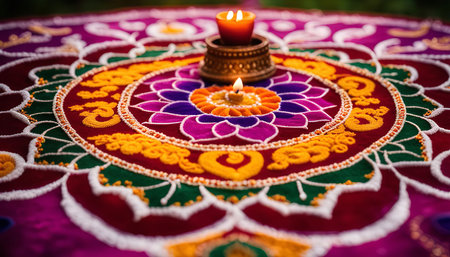Significance of Colour Energy during the Auspicious Sawan Season
The vibrant energy of colours holds a special place in Indian culture, especially during the auspicious Sawan season. As the monsoon rains rejuvenate the earth, people across India embrace hues that symbolise renewal, devotion, and prosperity. From lush greens reflecting nature’s abundance to radiant yellows and reds representing vitality and divine blessings, each colour worn or used in rituals carries deep significance. During Sawan, devotees observe fasts, visit temples, and engage in traditional practices where specific colours are believed to amplify spiritual vibrations and attract positive energies. This cultural affinity for colours not only fosters collective harmony but also stimulates economic activity—local artisans, textile merchants, and florists witness a surge in demand for colourful offerings, garments, and decorative items. Thus, the energy of colours during Sawan weaves together spirituality and commerce, reinforcing a cycle of well-being and prosperity across Indian society.
2. Cultural and Spiritual Meaning of Colours in Raksha Bandhan Celebrations
Raksha Bandhan, celebrated across India with immense devotion and joy, is a vibrant festival that beautifully intertwines the energy of colours with the sacred bond between siblings. The tradition of tying the rakhi is not just a ritual but an expression of deep-rooted cultural values and spiritual symbolism, where every hue carries a specific meaning that enhances the emotional connection.
The Symbolism Behind Rakhi Colours
During Raksha Bandhan, sisters carefully choose rakhis in colours that resonate with their wishes for their brothers. Each colour embodies a unique energy and intention, reflecting protection, love, and overall well-being. The selection of rakhi hues is deeply influenced by traditional Indian beliefs and spiritual associations.
| Colour | Cultural & Spiritual Meaning | Significance in Raksha Bandhan |
|---|---|---|
| Red | Symbolizes strength, protection, and purity | Blesses brothers with courage and shields them from negativity |
| Yellow | Represents wisdom, prosperity, and happiness | Conveys prayers for success and joyful life ahead |
| Green | Denotes renewal, growth, and harmony | Fosters peace in sibling relationships and family unity |
| Blue | Stands for trust, loyalty, and calmness | Deepens trust between siblings, ensuring a stable bond |
| Purple | Signifies dignity, devotion, and respect | Honours the sacredness of the sibling relationship |
The Emotional Energy in Rituals and Gifts
Sisters often match the colour of the rakhi with auspicious tilak powders (kumkum or turmeric), sweets, and festive attire to amplify the positive energy exchanged during rituals. Brothers reciprocate by gifting colourful tokens and pledging lifelong support. This thoughtful use of colours strengthens familial ties while invoking divine blessings for health, prosperity, and longevity.
A Reflection of Indias Diverse Culture
The spiritual importance placed on colours during Raksha Bandhan also highlights Indias rich tapestry of traditions. From north to south, east to west, families embrace local customs but universally honour the belief that colours carry vibrations capable of nurturing relationships. Thus, every Raksha Bandhan celebration becomes a harmonious blend of cultural identity, emotional resonance, and spiritual intent — all articulated through the powerful language of colours.

3. Janmashtami: The Divine Palette of Lord Krishna
Unveiling the Spiritual Energy of Colours
Janmashtami, the auspicious celebration of Lord Krishna’s birth, is a festival where colours play a pivotal role in both spiritual and cultural expressions across India. Each hue chosen during this vibrant time holds deep-rooted symbolism, infusing homes and hearts with sacred energy that resonates through generations.
The Significance of Blue and Yellow
Blue, representing Lord Krishna himself, signifies infinite potential, calmness, and divine love. Devotees often decorate temples and idols with blue attire and adornments to invoke the serene yet powerful presence of Krishna. Yellow, another prominent colour during Janmashtami, symbolises prosperity, knowledge, and abundance—qualities that families seek to invite into their lives by offering yellow sweets (like peda) and wearing yellow garments.
Flourishing Family Bonds Through Colourful Rituals
The rituals performed during Janmashtami are incomplete without the use of vibrant rangolis, flower garlands, and traditional attire in hues of red, green, orange, and gold. Red is believed to energise familial ties and signify auspicious beginnings; green fosters harmony and growth within the household; while gold reflects success and wealth. These colours are not merely decorative—they amplify the devotional atmosphere and set intentions for abundance in relationships and finances alike.
Cultural Resonance: Connecting Devotion & Prosperity
Across Indian cities from Mumbai to Chennai, families come together to sing bhajans and perform dahi handi rituals dressed in a symphony of colours that mirror Krishna’s playful spirit. This collective display not only enhances devotion but also attracts positive business energy, reinforcing unity and prosperity in both home and enterprise. The energy harnessed through these sacred colours transforms Janmashtami into a celebration where spiritual wellbeing aligns with material abundance—a true testament to India’s timeless connection between colour, culture, and commerce.
4. Indian Business Wisdom: Leveraging Festive Colours for Prosperity
India’s festivals are not just a celebration of tradition, but also a strategic opportunity for entrepreneurs and households to harness the potent energy of colours. During Sawan, Raksha Bandhan, and Janmashtami, the choice and use of specific colours play a pivotal role in attracting positivity, growth, and wealth. Indian business owners have long understood that aligning their offerings and environments with auspicious colours can enhance harmony within teams, attract customers, and create prosperity.
Colour-Driven Strategies in Indian Enterprises
Indian businesses often incorporate festive colours into their branding, store decor, marketing campaigns, and even staff attire during these periods. For example, green is widely used during Sawan to invoke freshness and renewal; vibrant reds and golds dominate Raksha Bandhan promotions for their association with protection and success; while Krishna-blue themes during Janmashtami symbolise trust and divine blessings. These choices are not random — they are deeply rooted in Vastu Shastra and cultural wisdom, believed to channel powerful energies for growth.
How Households & Businesses Channel Colour Energy
| Festival | Key Colour(s) | Significance | Common Practices |
|---|---|---|---|
| Sawan | Green | Renewal, Fertility | Decorating spaces with plants, wearing green attire |
| Raksha Bandhan | Red & Gold | Protection, Prosperity | Tying colourful rakhis, gifting gold-hued items |
| Janmashtami | Blue & Yellow | Divinity, Joy | Dressing deities in blue/yellow; blue décor accents |
The Business Impact: Real-World Examples
During these festivals, jewellery stores launch gold-themed collections to capitalise on Raksha Bandhan’s energy of abundance. Retailers introduce green-themed offers in Sawan to encourage fresh beginnings. On Janmashtami, FMCG brands roll out blue packaging or Krishna-centric campaigns to connect with families seeking divine favour. Such strategies do not just boost sales—they foster a sense of harmony and belonging among employees and customers alike.
This deliberate integration of colour energy is a testament to Indian business wisdom—where spiritual traditions seamlessly merge with modern entrepreneurial tactics to invite lasting prosperity.
5. Practical Tips: Incorporating Vibrant Colours into Modern Indian Lifestyles
Bringing Auspicious Colours Home During Sawan, Raksha Bandhan & Janmashtami
Infusing your home with the right colours during these sacred festivals can significantly amplify positive energy. For Sawan, adorn your living spaces with shades of green and yellow—consider fresh curtains, cushions, or table runners to evoke prosperity and harmony. During Raksha Bandhan, use pinks, reds, and gold accents in your décor, symbolising love and abundance; a simple rangoli at the entrance or vibrant torans can set an auspicious tone. For Janmashtami, integrate blue, peacock hues, and silver accessories—think about blue drapes or Krishna-themed wall art to attract spiritual blessings.
Colourful Choices in Business Settings for Prosperity
Colours play a powerful role in driving business energy and success during festive times. In offices or retail spaces, incorporate elements like saffron or maroon in your interiors to ignite motivation and wealth creation. Place green plants in strategic locations to foster growth and fresh ideas. You can also encourage employees to wear specific festive colours on key days—this not only boosts morale but aligns collective intention towards prosperity. Displaying symbolic artefacts in gold or yellow tones near entrances is believed to attract Lakshmis blessings.
Fashion as a Manifestation Tool
Your attire is a statement of your intentions during these festivals. Opt for traditional ensembles in auspicious shades: women may choose green sarees or kurtis for Sawan, red or pink attire for Raksha Bandhan, and blue or white clothing for Janmashtami celebrations. Men can pair kurta-pajamas in similar hues with colourful stoles. Accessories matter too—wearing gold jewellery or colourful bangles enhances both beauty and energetic attraction. Remember, dressing vibrantly is not only about style but also about invoking positivity and confidence.
Quick Tips for Everyday Colour Integration
- Light incense or lamps in coloured holders matching the festival’s dominant shade.
- Add fresh flowers like marigold (for Sawan), roses (for Raksha Bandhan), or jasmine (for Janmashtami) to your pooja room or workspace.
- Gift loved ones items in auspicious colours—like scarves, wallets, or home décor pieces—to share good fortune.
Cultivating a Colour-Conscious Mindset
Consciously choosing vibrant colours aligned with each festival’s spirit transforms daily life into an ongoing celebration of abundance and harmony. Whether at home, work, or through your wardrobe choices, let colour be your partner in attracting success, joy, and spiritual elevation throughout India’s festive season.


